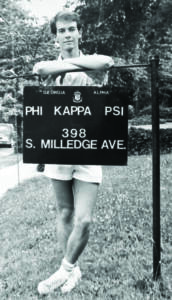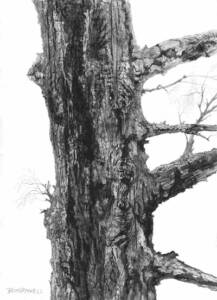From New Orleans to New York, and from Charlotte to Chicago, Phi Kappa Psi Brothers of all ages are making their creative mark in meaningful ways through gallery exhibitions, at art studios and in private collections across the country — and even around the world.
Recognizing fellow ROTC members in the Fraternity was what initially swayed Wil Bosbyshell Georgia ’80 to pledge Phi Kappa Psi as an undergraduate. In the years that followed, he found ample brotherly support not only for his service commitments, but also for his art studies.

Bobyshell
“It was exciting and great fun to live at the house during my junior and senior years,” he said.
In an unexpected turn of events, Wil found out he was a legacy and didn’t even know it.
“My father was a Phi Psi at Swarthmore College in Pennsylvania back in the 1950s,” he laughed. “It wasn’t until after I told him I’d pledged Phi Psi that he said, ‘Oh, I was a Phi Psi, too!’ We’d somehow missed that.”

Bosbyshell proudly supporting Georgia Alpha
After receiving his Bachelor of Fine Arts in 1983, Wil served six years in the United States Army with stations in Alaska and Savannah, Georgia, before returning to the University of Georgia to earn a master’s degree in 1990.
“We had a Tutor-in-Residence Scholarship at the time,” he said. “As a graduate student, it paid my rent to live in the house and take on the role of resident graduate assistant for the Fraternity. Basically, I was a house father.”
A business career came next, and then an art residency at the Hungarian Multicultural Center in Budapest. In 1993, Wil moved to Charlotte, North Carolina, to work as a graphic designer, later opening his own studio in the North Davidson Arts District.
These days, he continues to exhibit his work and teaches at local and technical community colleges. He also remains in close touch with two generations of Phi Psi Brothers from his stints in the UGA house. He even played a role in helping to construct a new residence for the chapter in 2015.

One of Bobyshell’s Climate Conversation drawings
“Some of my best friends in college were my Brothers at the Fraternity, and they’re still my best friends,” he said. “As a past president and current secretary of the Georgia Alpha House Corp., I’ve also made new friends with other Phi Psi alumni.”
Self-proclaimed absurdist painter Gunner Dongieux Stanford ’18 is also going places through his art. Born and raised in New Orleans, Gunner ventured west to attend Stanford University after a post-high school gap year. Like Wil, he says the friends he made through Phi Kappa Psi remain his closest contacts.

Dongieux
“Four of us lived together in the top room of the house called the quad,” Gunner said. “One’s now in Germany, one’s in New York and one’s in L.A., and we still check in with each other all the time.”
In addition to the lasting friendships he made in the house, Gunner credits his role as Fraternity chaplain with helping him to improve his public speaking and leadership skills. After graduating in 2022 with a bachelor’s degree in art practice, Gunner moved to New York City where he now operates a collaborative project space called Pop Gun, which he runs with his girlfriend out of their Brooklyn apartment. Networking with Phi Psi Brothers and attending alumni events has proved invaluable in furthering his art career.
“Most of my collectors have come through those connections,” he acknowledged. “My fellow Phi Psis have commissioned my paintings and road-tripped to see my shows and exhibitions. They’ve really been supportive of me in a lot of different ways.”
Next up for Gunner: grad school in Hamburg, Germany, where he plans to study painting and pave the way for a professorship down the road. As for the long-term future, who knows?
“My dad says that if you grew up in New Orleans, you’ll always find your way back there,” Gunner said. “Hopefully there will be some Phi Psis around! College isn’t so much about the classes you take. It’s more about the people you meet and the relationships you create. That’s definitely what Phi Psi is for me.”
A second-year student at the University of Toledo, Duncan McLean Toledo ’23 is still discovering and honing his artistic style, working with natural inspiration and exploring movement in still objects.

McLean
“I prefer to work in ceramic media through wheel-thrown, slab-built and sculptural work,” he explained.
Duncan admitted he wasn’t all that keen on the concept of Greek life when he started college, but the Phi Kappa Psis he met during Rush changed his mind.
“I knew that this was a place where I would feel welcome and pushed to become the best version of myself, while also gaining valuable leadership skills,” he said. “Phi Psi has shaped my college experience through friendships, networking and opportunities to become involved on campus, allowing me to grow socially and intellectually.”
 As Duncan continues to work toward an Honors Bachelor of Fine Arts with a 3-D concentration, he said he’s grateful for ongoing encouragement from his Phi Psi Brothers.
As Duncan continues to work toward an Honors Bachelor of Fine Arts with a 3-D concentration, he said he’s grateful for ongoing encouragement from his Phi Psi Brothers.
“The Fraternity has definitely influenced my art, and I often ask the people around me for ideas and critiques,” he said. “They typically respond with overwhelming support.”
At first, Duncan viewed Brotherhood as a pathway to becoming more engaged with the campus and Toledo community. While that holds true, he said he has an increasingly greater respect and appreciation for the values fraternity life has instilled, even beyond the bonds of Phi Psi itself.
“Being active in Greek life has become a way for me to make instant connections,” he explained. “I learned my sculpture professor and Honors program mentor was a Sigma Phi Epsilon at Toledo 30 or so years ago. The simple fact that we both were and are part of UT Greek life has helped us to connect and opened opportunities for me.”






.jpg)











































.jpg)


